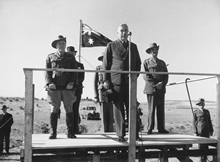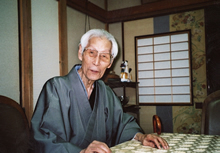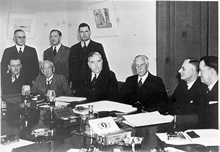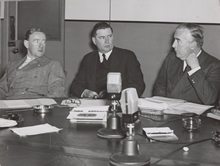
Kawai's arrival at a critical time
The Canberra Maru carrying Tatsuo Kawai entered Sydney Harbor on 13 March 1941 where a large press contingent awaited. In Brisbane he had already called for 'less diplomatic jargon and plainer, straight-from-the shoulder' talk. 14
Kawai assured waiting reporters that the Tripartite Pact with Germany and Italy did not conflict with the maintenance of peaceful relations between Australia and Japan:
'We have no desire to expand south in the military sense, but we do earnestly wish to have economic ties with your country.' 15
Coincidentally, on the day of Kawai's arrival in Sydney, the Australian Parliament was in special joint secret session of members and senators to hear the Government reveal the extent of its information on Japan's intentions, as well as Australian and British naval dispositions and defence strengths.
Tatsuo Kawai appeared in the corridors of Parliament House that afternoon and was pictured chatting and joking with Australian ministers, including Attorney General and Navy Minister, William Hughes, an ardent critic of Japan's militarism.
The following day, Kawai presented his credentials to Governor General, Lord Gowrie, at Government House.

The Canberra Maru.
From: Noma, H.
Japanese Merchant Ships at War.
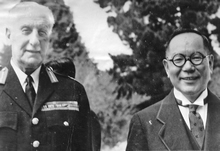
Tatsuo Kawai with the Australian
Governor-General Lord Gowrie on his inauguration as Japan's first
ambassador to Australia in March 1941 (the day he met John Curtin).
Photograph from the Kawai family collection at Manazuru.
JCPML01224/37.
First meetings with Kawai
On the evening of 14 March 1941, Tatsuo Kawai and John Curtin met for the first time at a Government House reception in the new envoy's honour. Guests mingled with Kawai after the dinner. Kawai had been anxious to meet the Opposition leader, given that he might gain the numbers to form a new government at any moment. Kawai was immediately taken by Curtin, privately writing in Japanese tanka soon after:
'Introduced to Mr Curtin,
Leader of the Opposition,
I shake his hand:
I will never forget his face.'
The two fell into easy conversation about relationships, diplomacy and war. Kawai introduced his colleague and friend, Tsuneo Hattori, the new Melbourne Consul, a moderate, who years later would write of the association between Kawai and Curtin:
'It was at this banquet that Tatsuo introduced me to the leader of the Labour Party, John Curtin. Tatsuo was deeply impressed with Mr Curtin's simple, unpretentious manner of speaking; Mr Curtin also appeared to take note of Tatsuo's solid character. Before he left he made a promise to meet with Kawai soon. Following that the two men became increasingly close, baring their hearts to one another and exchanging opinions.' 16
Arthur Fadden was a down-to-earth politician who mixed easily. He hoped that Kawai's arrival might ease the tensions over Japan. After the formal dinner, Kawai retired to his hotel with Hattori, pleased with how the day had gone. Hattori later recalled a surprising late night visit by acting Prime Minister Fadden, Army Minister Spender and secretary of the External Affairs Department, William Hodgson:
'(They) followed us back to the hotel in Canberra ... unexpectedly calling into the Minister's room to congratulate him on his inauguration and offer their best wishes towards the furtherance of friendly relations between the two countries as they made toasts and animatedly chatted the night away. Tatsuo was quite delighted and went to some effort to cater for his unforeseen guests, but he sensed the expectations of the esteemed Australians and both deeply impressed us and gave us great hope.'
Kawai also wrote his own fleeting verse about the Fadden's visit:
'Bright and peaceful,
An exciting sojourn at the hotel in Canberra.'
But Kawai too could sense the concern of Australians:
'Wherever I go,
People are slightly suspicious of war.'
Following Fadden's late night 'party' with Kawai and friends in the Hotel Canberra, the acting Prime Minister felt comfortable leaving private discussions with the new envoy in the hands of his friend, John Curtin, despite Curtin being on the other side of politics. 17
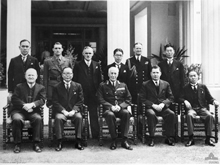
Kawai's inauguration as Japan's first ambassador to Australia in March 1941. Kawai, Lord Gowrie and Acting Prime Minister Arthur Fadden
are 2nd to 4th figures in the front row. Courtesy Australian War Memorial,
006093.
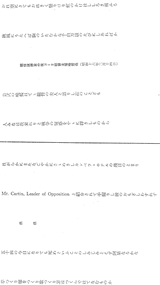
Tanka written by Tatuso Kawai following
his first meeting with John Curtin at Government House. Click image to view original Japanese text and English language translation.
JCPML01219/72.
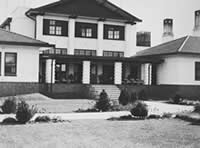
Sunken Garden, Hotel Canberra.
Part of the Mildenhall collection of photographs of Canberra.
Courtesy of the
National Library of Australia,
bib ID vn2297378,
call no. PIC P583, album 827.
Rising tensions with Japan
Tatsuo Kawai's initial diplomatic exuberance soon diminished. In his first weeks in Australia, the Menzies-Fadden Government had mostly formal contact with the Japanese ambassador.
Some of these contacts were barely disguised disagreements as Japan continued her war-like threats and preparations. The Australian Government refused to accept four Japanese defence attaches in Australia, given the state of war with Germany, Japan's Axis partner.
In the Dutch East Indies (Indonesia), documents and sketches which concerned Australian defence facilities were found on a Japanese agent, resulting in further bitter differences.
The External Affairs Minister, Sir Frederick Stewart, wanted to 'get together' with Kawai, as he was sure they could find a way out of the growing impasse in relations, but he thought such an approach would be interpreted as a sign of weakness. Stewart's private secretary Ralph Harry commented that 'John Curtin did what Stewart was unable to do'. But Curtin was running the risk of continuing to appease Japan at any price. 18
Fadden and Stewart were soon exchanging public insults with Kawai. Kawai said a prediction by Fadden that Japan's 'southward move' would be timed with European developments had not eventuated. He warned that if provoked, Japan would respond, saying if someone approached a strange dog with mistrust and suspicion, the dog naturally was 'likely to become vicious'.
Stewart quickly responded that Australia's paramount concern was its engagement in war on the side of Britain against Germany and Italy. Japanese spokesmen, he believed, should bear this in mind 'when alleging Australian mistrust and suspicion'. 19
At Kawai's inauguration dinner, Curtin had told Kawai he was anxious to resume their discussions about war and peace. On 28 April Kawai paid a courtesy call on Curtin in Melbourne. Afterwards Curtin said he had enjoyed 'a frank and full conversation with Mr Kawai on matters of interest'. He greatly appreciated the call, which he soon would return. 20
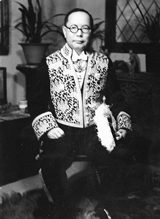
Tatsuo Kawai in diplomat's uniform,
Japan, ca. 1940.
Photograph from the Kawai family collection at Manazuru.
JCPML01224/51.
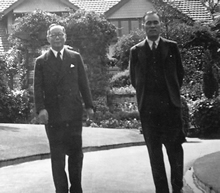
Tatsuo Kawai with Melbourne Consul Tsuneo Hattori at Carn Brea, Melbourne, 1941. Photograph from the Kawai family collection at Manazuru.
JCPML01224/53.
A proposal to 'guarantee' Australia's survival
Curtin and Kawai soon found an understanding for discussion based on frank exchanges.
Much later Kawai set down for posterity the detail of this first long discussion with Curtin. Kawai wrote that he had merely intended to say a few words of greeting, yet somehow it became 'a lengthy, personal conversation, a frank discussion on how to disentangle the present, increasingly grim Japan-Australia relations'. According to Kawai, writing in Japan in 1962, Curtin asked him if war with Japan could be avoided. Kawai documented their discussion in a series of dot points, in which the envoy gave his diplomatic guide to peace:
- 'And in this world, in a strange country, this politician of such distinctive character appears.
- He was underrated in Japan. Not any more.
- It is at once enviable and also somehow sad.
- Is there no hope of Japan getting out?
- Actually, no, it is not an issue of whether there is hope or not. It is an issue of getting out or not.
- We must thoroughly think this issue through, then cut open a path to that.'
Kawai said both men agreed to use the known deposits of iron ore at Yampi Sound in Western Australia as a means of guaranteeing Australia from Japanese attack. Kawai said doubts between the two countries were growing by the day, as seen by the state of deteriorating trade:
'Focusing on this point we proposed a collaborative effort to deliberately boost trade. We concurred that if that could mitigate the tension, it might become an avenue to unlock the unexpected state of affairs.
'Our conversations then went on to discussion of specific measures. Following that his demeanour formalised as he said, "If Japan will do that for us, then it would be okay for the subordinate Australian side to lift the seizure of the Yampi Sound" - at the time a Japanese company effectively held the mining rights to this famous and resource-rich mine - but Japan must guarantee Australia's safety.
'Speaking to me from his heart, he added, "Don't take what I have said thus far as the candid words of someone in no position of responsibility. My Labour Party is the Opposition at the moment, but it holds an equal amount of Lower House seats to the two Coalition parties, and it is only the Chairman's seat that we are short of. I am also in a position whereby I can speak sufficiently to Prime Minister Menzies."'
Kawai made it clear that he was 'deeply impressed by his [Curtin's] attitude and character. From that moment my feelings of friendship towards him grew rapidly'. 21
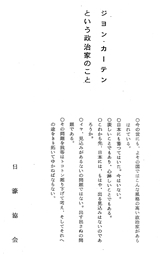
Kawai's article on his first discussion with Curtin about Japan-Australia relations, reproduced by Kawai in his article John Curtin: The Politician, published by the Japan-Australian Society, 1962. Click image to view original Japanese text and English language translation. JCPML01219/15.

Tatsuo Kawai in the conservatory of his rented house "Carn Brea", 5 Harcourt Street, Auburn, Melbourne, ca. 1941/42. Photograph from the Kawai family collection at Manazuru.
JCPML01224/35.
Uninhibited, confidential peace talks
There was intensity in Curtin's concerns about the Japanese threat. Australia was having difficulty convincing Britain to send a fleet to Singapore, knowing Malay defences were weak. Australian troops were still being sent to the Middle East, rather than being retained in Australia. Fadden and Curtin were shocked to learn that a large part of the American fleet in the Pacific might be moved to the Atlantic.
Curtin now had no doubt about the potential of Japan to thrust further southwards, perhaps all the way to Australia. Two days after meeting Kawai, Curtin, at an Advisory War Council meeting in Melbourne, stressed that priority for new equipment and ammunition should be given to 'the defences necessary in our outer ramparts to prevent and resist direct attack against Australian shores'.
Curtin still feared pushing Japan into war by denying her raw materials. While the US, Britain, Australia and others had certain trading restrictions against Japan, the subsequent freeze on Japanese assets and major embargoes were still three months away. Kawai never gave up on the idea of securing Australian iron ore. 22
Contact between Kawai and Curtin now took the form of regular secret discussions. They spoke to each other without inhibition, each outlining his country's concerns and aspirations. Kawai's respect for Curtin's character grew, as can be seen in a covert cable from Kawai about Curtin to Foreign Minister Yosuke Matsuoka on May 7:
'Whilst he is not a scholar of Japan, he does possess an awareness and understanding of Japan's real ability, culture, and morals or the difficulties at hand. A deep thinker on issues pertinent to Japan-Australia relations, he listens with an open mind to debate over the friendship between the two countries and is a magnanimous man of considerable character.' 23
Kawai's post war friend and neighbour, Toshio Takeuchi, of Manazuru in the Kanagawa prefecture, recalled Kawai talking of Curtin in Japan after the war:
'He mentioned that as he (Curtin) was a personal friend, above the official line. Always he was invited by (Curtin's) family. Not as ambassador, well at the official level as ambassador to Australia, but as his friend.' 24
Diplomat Taijiro Ichikawa, now deceased, was Kawai's commercial secretary in Canberra in 1941 and a close friend. Ichikawa, speaking in Japan in 2002, said the Japanese legation arrived thinking Australia to be 'a near neutral place':
'So he (Kawai) approached Curtin first to find out their view of Australian politics. Then gradually he was charmed by the character of Curtin. Kawai must have been impressed by the open-mindedness of the Australians he approached... He always said, "Australians are honest! Open minded."' 25
Curtin's impressions of Kawai's character are not recorded. Yet soon he would invite the envoy into his home.
Curtin did, however, make clear the basic reason for his continual dialogue with Tatsuo Kawai. He wanted to reach an understanding with Japan and encourage the dwindling band of anti-war moderates in Japan, as the minutes of the Advisory War Council in Melbourne on June 5, 1941, reveal:
'Mr Curtin referred to conversations which he had had with the Japanese Minister in Australia regarding the possibility of reaching a basis of understanding, and referred to the body of well-disposed opinion in Japan which needed encouragement to sustain it.'
The War Council agreed there was no objection to Curtin continuing his dialogue with Kawai. 26
Relationships on different levels
Prime Minister Menzies returned from London to Australia on 26 May 1941. Arthur Fadden, who had been Acting Prime Minister, found him irritable about returning 'to play the diabolical game of politics in Australia'. Menzies was appalled at the petty political debate in Australia in comparison with Britain's unity. His attitude and demeanour also set him on a collision course with his own political colleagues.
Menzies had returned inspired by Britain's example in the conduct of the war and convinced of the growing danger to Australia. But he was wary of offending Japan. Above all, he desperately wanted to return to London to represent Australia's interests on the international stage.
The relationship between Kawai and Menzies was on a different, more formal footing than that between Kawai and Curtin. As time went on Menzies was happy to leave the private discussions with the Japanese envoy to Curtin. Nonetheless, Menzies and Kawai met several times and exchanged letters, mostly on trade. As Kawai's son Masumi would later say:
'John Curtin was a gentleman who impressed my father very highly - deeply and highly. More than anyone! So Menzies, of course you know, officially very close but personally and privately (the) close gentleman was John Curtin...'
Kawai wrote pleading letters to Prime Minister Menzies and his ministers on Japan's growing trade difficulties with Australia. At one meeting, Menzies invited Kawai to set out his frank opinions on Japan's trade problems with Australia. Kawai did so on 21 June 1941, referring to restrictions on exports to Japan of cotton goods, and telling Menzies somewhat hopefully:
'I firmly hold the view that, whatever may be the situation now prevailing, the social and economic relations between Australia and Japan are destined ... to become increasingly closer, and therefore, it is my belief that adequate steps should be taken now to endeavour to pave the way for the days to come.'
Ever hopeful, Kawai asked Menzies if he was ready to entertain the idea of Australia and Japan entering into a trade agreement. The Menzies Government was not.
Menzies walked a tight-rope trying to avoid provoking Japan. He appeared torn between strong warnings and outright appeasement. His government favoured blocking Australian exports that might be passed on to Nazi Germany, while attempting to generate pressure on Japan through Britain and the United States to get Japan to moderate its expansionism.
When Kawai asked Menzies to allow the export of copra oil from New Guinea to Japan, Menzies rejected the proposal, noting that Japan was exporting vast quantities of copra oil to Germany. But Menzies added: 'I earnestly hope that your Government does not overlook the ready co-operation that has been forthcoming from Australia...' The most recent 'evidence of our desire to assist Japan', Menzies added, was a decision to permit the export of 20,000 Corriedale sheep.
Kawai stepped up his campaign to influence Australians of note. He became renowned as a host at his Carn Brea mansion in Melbourne, frequently entertaining in his timber panelled ballroom. His guests included Australian captains of industry, government officials, judges, newspaper owners, journalists and others. 27
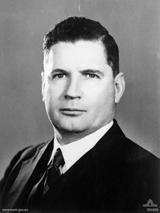
Arthur Fadden, 1940.
Courtesy of the Australian War Memorial, 001926.
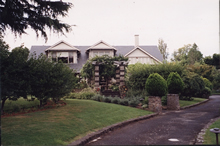
Carn Brea. Tatsuo Kawai's home in Auburn, Melbourne. 2004. Records of Bob Wurth. JCPML01224/2.
Grim news in Cottesloe
John Curtin continued talking privately with Tatsuo Kawai as tensions with Japan grew. In July 1941, their relationship was sufficiently robust that Curtin invited Kawai to his home in Western Australia.
At Curtin's invitation, the envoy made a 16-hour flight from Melbourne to Perth via Adelaide to dine with John and Elsie Curtin at their family home at 24 Jarrad Street, Cottesloe. The timing of his arrival was most inopportune for Kawai. The day after Kawai's arrival in Perth, newspapers carried stories of massive Japanese troop movements. The reports correctly indicated that Japan was about to attack southern Indochina, having already secured northern Indochina.
The Curtins not only dined with Kawai at their home, but John Curtin also escorted the envoy to a series of meetings with prominent officials and then staged a formal dinner party in Perth for the ambassador. Curtin's wife Elsie warmed to Kawai:
'Dad [Curtin] gave a dinner party for him in Perth, but, according to a Japanese custom, he had to eat in our house first before he could accept hospitality outside. He brought me the jewel box, [daughter] Elsie a cherry coloured lacquered ball... and my mother a sandalwood fan. It was only a few months before Pearl Harbor and 'Dad' was criticised later for having entertained the Minister. His reason for the dinner was to maintain friendly relations with Japan as long as possible.' 28
Being frank and open, the private talks between Kawai and Curtin were not always harmonious. From Curtin's subsequent words, Japan's southern movement almost certainly produced a resounding clash of philosophies.
With newspaper headlines tracking Japan's latest southward thrust, Kawai left Perth in a testy mood. Reporters descended on the diplomat when his aircraft landed to refuel at Adelaide. Kawai's responses to questions were no longer reassurances of peace and friendship.
Time magazine wrote that Kawai's statements were the most engaging recent international comments on Japan's true intentions:
'Asked whether Japan would move southward as far as Australia, Mr Kawai said that would depend on the provocation. Asked whether Australia had been provocative, he said there had been a few pinpricks. Asked whether Japan desired territorial expansion towards the (Netherlands East) Indies (now Indonesia) he said territorial expansion was an old-fashioned phrase.'
As Kawai was talking in Adelaide, Prime Minister Menzies in Sydney noted that a Japanese move in Indochina might not cause war, but would have very sharp repercussions. Tough economic sanctions by the US, Britain, Australia and other nations against Japan soon followed the southern Indochina occupation.
Long discussion in the Advisory War Council meeting of 29 July on Indochina produced much worried and often confused debate and conflicting statements by both members of the Menzies Government and the Curtin Opposition. 29
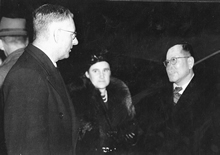
John and Elsie Curtin greeting Tatsuo Kawai at Perth airport, July 1941. JCPML01224/75.
Courtesy of West Australian
Newspapers Ltd.
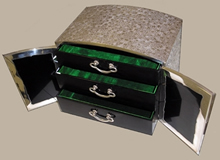
Silver jewellery box presented to Elsie Curtin by Tatsuo Kawai on a vist to Cottesloe, January 1941. Records of Elsie Curtin. JCPML00373/4.
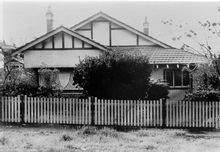
Curtin house, 24 Jarrad St Cottesloe, 1943. Records of the Curtin Family. JCPML00376/36.
Turmoil over Japan's southward thrust
Kawai was now depressed about the chances of improving relations and trade with Australia. Writing privately on 9 August to his Australian counterpart in Tokyo, Sir John Latham, Kawai said:
'It must be very trying for you, as it is for me, to have to endeavour to allay this uneasiness, which is daily growing worse. But, I am determined not to slacken my efforts...'
The political turmoil in Australia soon came to a head. Menzies decided to abandon a tour of Australia and hold a Cabinet meeting in Melbourne on 11 August to determine what policy would be adopted if Japan invaded Thailand.
When the Advisory War Council met three days later, Prime Minister Menzies said import and export controls involving Japan were in existence and a commercial treaty with Japan had been denounced.
Curtin, clinging to hopes of peace, thought there was still a chance of avoiding war through negotiation:
'Japan was still susceptible to a face-saving arrangement and Government should talk to Government in a frank manner to ascertain if a solution was possible.'
But Curtin said that if war with Japan was considered inevitable, 'we should bring pressure on [the] USA to knock Japan out now. If not, we should not be pushed into war when it is to our great prejudice in other theatres'. Curtin urged the importance of frank discussion 'with a view to drawing a chalk line to mark the limit of Japan's southern advance'.
Kawai's attempted intimidation of Curtin
The Prime Minister then revealed that Kawai had suggested to him that he (Menzies) should go to Tokyo 'to check the drift of the situation'. Menzies was wary though, recalling to the War Council the visit to Munich by British leader Neville Chamberlain in 1938 'and the consequent criticism that he ultimately incurred for appeasement'.
Menzies did not see why Japan should not be told that 'we are not engaged in appeasing you', but were prepared to take action 'in the event of specifically defined Japanese events'. Curtin agreed.
The Minister for the Army, Mr Percy Spender, asked the Minister for External Affairs, Sir Frederick Stewart, whether he had had any discussions with Mr Kawai. Stewart said he had not. At that point, Mr Menzies told the War Council that he was seeing Mr Kawai at 5.30 pm that day.
The Council minutes then recorded that it was the Opposition leader, Curtin, who had maintained the personal continued contact with Kawai. Curtin had acted with Menzies' co-operation and passed on the details of his talks to the Prime Minister. It was then that Curtin revealed that Kawai had attempted to use bullying tactics in their recent private meetings:
'Mr Curtin ... outlined his interview with the Japanese Minister [Kawai] and the intimidatory attitude of the latter...'
Curtin said Kawai's remarks had come in discussion about the necessity for Japan to 'break the powers of the A.B.C.D.' The initials referred to America, Britain, China and the Dutch, who were allegedly 'encircling' Japan. Japan claimed that Australian and British reinforcements sent to Singapore posed an immediate threat to Thailand's sovereignty and Japan's stability. Curtin took Kawai's words seriously and warned his colleagues that it would be 'unwise to make any threat to Japan without the power to carry it out'. Menzies agreed.
That afternoon, Tatsuo Kawai entered the Australian defence headquarters at Victoria Barracks in Melbourne and was escorted to the first floor, the centre of Australia's defence planning. The Advisory War Council was meeting in the War Room through double doors to the left. Kawai was led to the right into the Prime Minister's office.
Later, Menzies spoke with reporters. They included the Asahi Shimbun newspaper correspondent from Tokyo, who asked Menzies if he could do anything to ease the tense situation. He replied that only Japan knew the answers:
'No action by Australia or any other British country produced the recent tension. We did not move into Indochina.' 30
